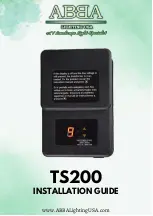
17-300-01 re
v.01
3/02
CAUTION
:
NEVER USE SOLVENTS
Cleaners, fuel, paint, sealants, and other products may
contain strong solvents, such as acetone, which attack
many plastics greatly reducing their strength.
IMPORTANT
: Please read these instructions
completely before proceeding with the installation.
These instructions supersede any other instructions in
your instrument manual if they differ.
Removable In-Hull Depth Transducer
Models: M256, M260
Applications
• Recommended for high speed boats
• Fiberglass hulls only
• Accommodates a deadrise angle up to 30°
Tools and Materials
Allen wrench:
3/16"
Rope
Detergent
or
weak solvent (such as alcohol)
Safety goggles (some installations)
Dust mask (some installations)
Disk sander (some installations)
Thin sealable plastic bag (optional)
Twist-tie
Water-based lubricant (such as K-Y
®
jelly) (optional)
Carpenter’s level
Pencil
Saw
Scissors
Adhesive (such as Boatlife
®
Lifeseal
®
or
3M
™
#4200)
or
fiberglass resin
Mineral oil (available at pharmacies)
Wrench
Assembling the Transducer
1. Thread the cable through the cable hole in the gasket and the
cable hole in the plate (see Figure 1).
2. Rest the gasket and plate on the transducer and align the
mounting holes. Fasten the three 1/4-20 x 1/2" screws and split
lock washers in place. Tighten with a 3/16" allen wrench.
3. Insert the two fill/vent plugs.
4. Thread the cable under the handle as seen in the drawing
above.
Mounting Location
Fiberglass Hull
Since the hull absorbs acoustic energy, transmitting through the
hull reduces the transducer’s performance. Fiberglass hulls are
often cored in places for added strength or to reduce weight.
These cored areas contain balsa wood or structural foam which
are poor sound conductors.
Do not
locate the transducer over
coring.
Caution
: Find an area of the boat where the fiberglass is solid (no
air bubbles are trapped in the fiberglass resin) and where no
coring, flotation material, or dead air space is sandwiched
between the inside skin and outer skin of the hull.
OWNER’S GUIDE & INSTALLATION INSTRUCTIONS
Figure 1. Assembling the transducer
Record the information found on the cable tag for future reference.
Part No._________________Date___________Frequency________kHz
screw (3)
split lock washer (3)
transducer
gasket
plate
1/4-20 x 1/2"
cable
fill/vent plug (2)
M260






















